Strategic Human Resource Management Report: Fletcher Buildings
VerifiedAdded on 2021/10/01
|20
|4397
|100
Report
AI Summary
This report delves into the strategic human resource management of Fletcher Buildings, a New Zealand-based firm. It begins with an executive summary outlining the report's objectives, which include assessing factors influencing HR strategies. The report then conducts a PESTLE analysis to evaluate the external environment, considering political, economic, social, technological, environmental, and legal factors. A SWOT analysis is also performed to identify the company's strengths, weaknesses, opportunities, and threats. The report identifies key HR issues within Fletcher Buildings, such as employee turnover and the impact of labor laws, and evaluates the company's strategic objectives. Based on the analyses, the report formulates specific HR strategies and policies, providing both practical and theoretical justifications for the recommendations. The report also includes an implementation plan and concludes with a discussion of potential risks and implications associated with the proposed strategies, supported by references and a bibliography.
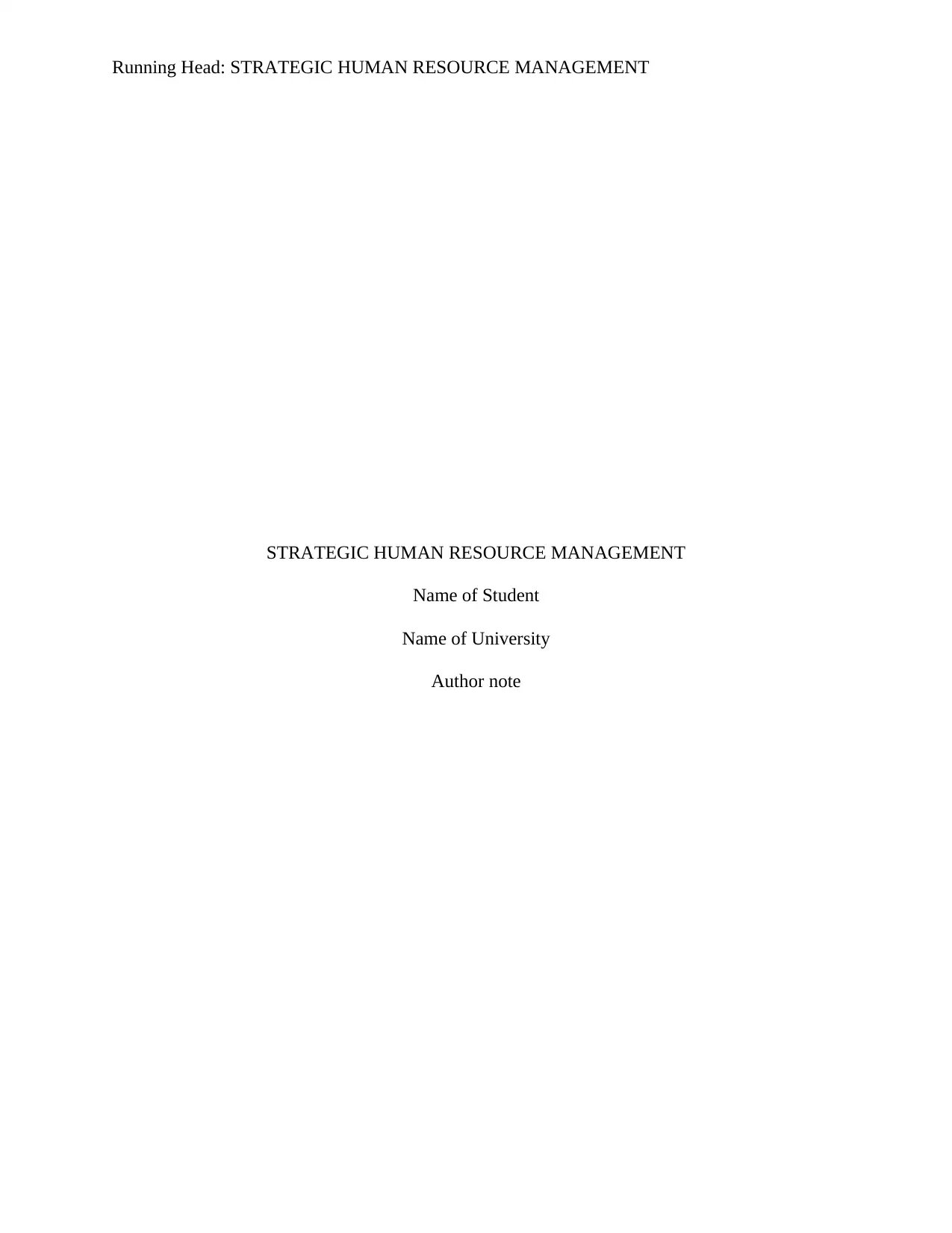
Running Head: STRATEGIC HUMAN RESOURCE MANAGEMENT
STRATEGIC HUMAN RESOURCE MANAGEMENT
Name of Student
Name of University
Author note
STRATEGIC HUMAN RESOURCE MANAGEMENT
Name of Student
Name of University
Author note
Paraphrase This Document
Need a fresh take? Get an instant paraphrase of this document with our AI Paraphraser
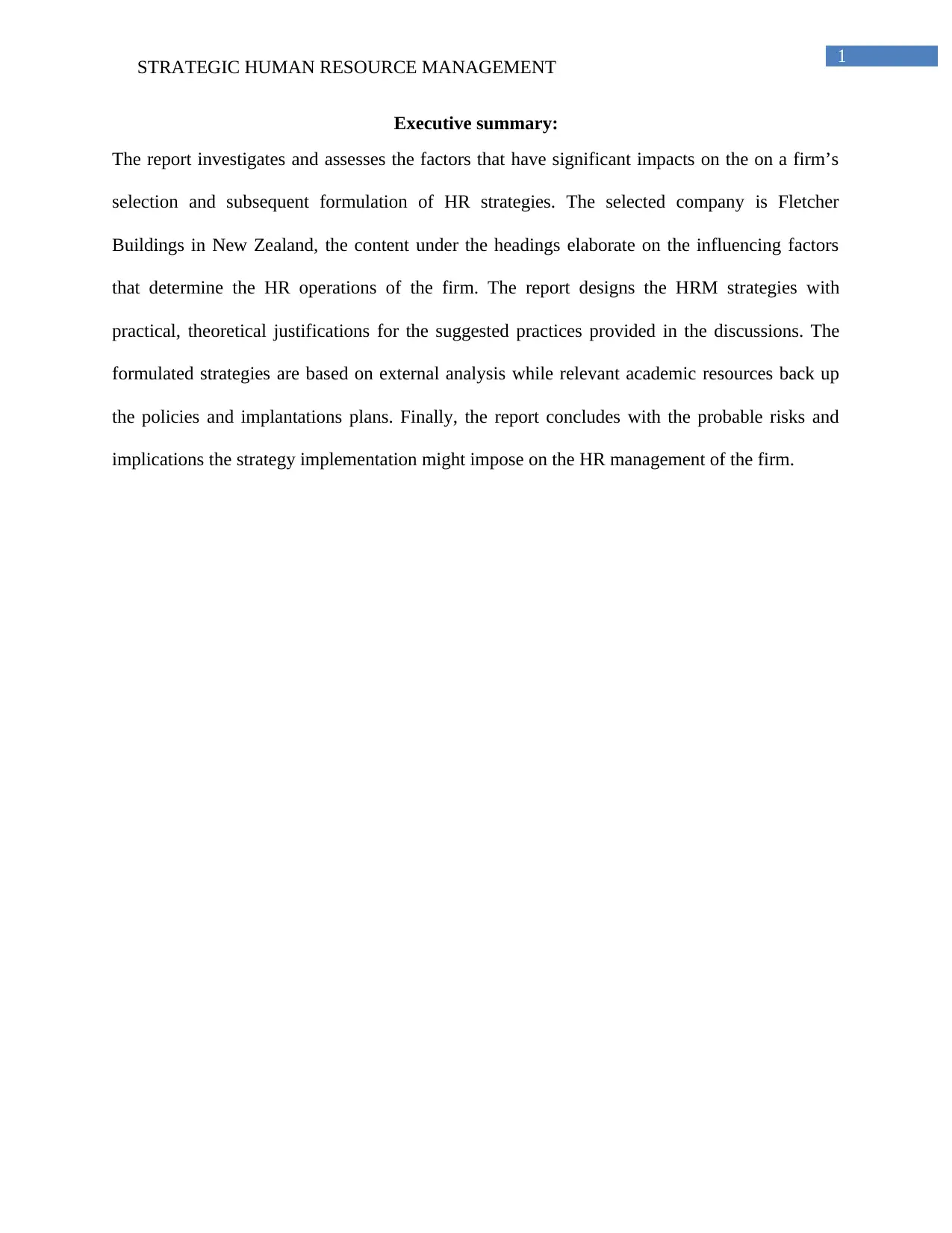
1
STRATEGIC HUMAN RESOURCE MANAGEMENT
Executive summary:
The report investigates and assesses the factors that have significant impacts on the on a firm’s
selection and subsequent formulation of HR strategies. The selected company is Fletcher
Buildings in New Zealand, the content under the headings elaborate on the influencing factors
that determine the HR operations of the firm. The report designs the HRM strategies with
practical, theoretical justifications for the suggested practices provided in the discussions. The
formulated strategies are based on external analysis while relevant academic resources back up
the policies and implantations plans. Finally, the report concludes with the probable risks and
implications the strategy implementation might impose on the HR management of the firm.
STRATEGIC HUMAN RESOURCE MANAGEMENT
Executive summary:
The report investigates and assesses the factors that have significant impacts on the on a firm’s
selection and subsequent formulation of HR strategies. The selected company is Fletcher
Buildings in New Zealand, the content under the headings elaborate on the influencing factors
that determine the HR operations of the firm. The report designs the HRM strategies with
practical, theoretical justifications for the suggested practices provided in the discussions. The
formulated strategies are based on external analysis while relevant academic resources back up
the policies and implantations plans. Finally, the report concludes with the probable risks and
implications the strategy implementation might impose on the HR management of the firm.
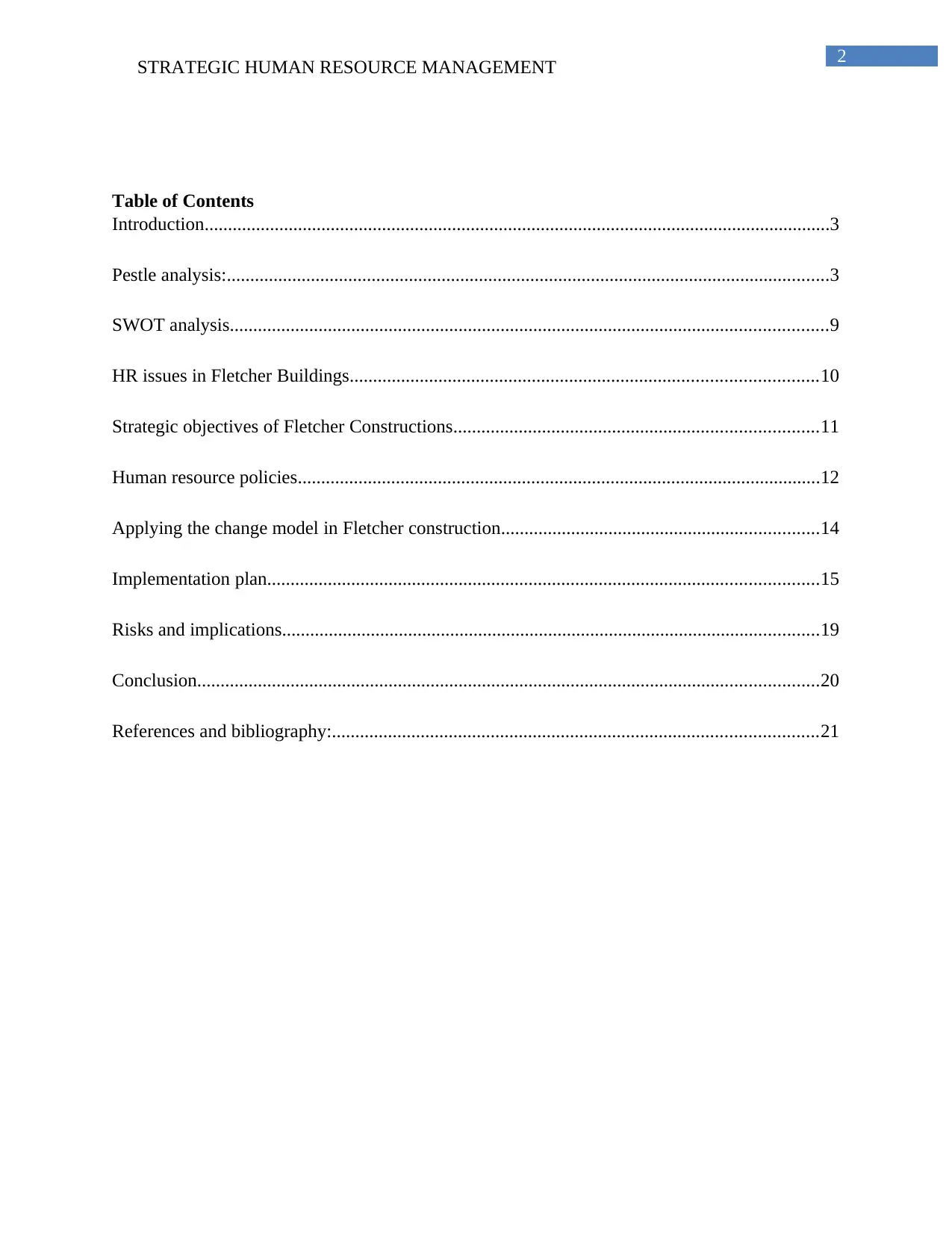
2
STRATEGIC HUMAN RESOURCE MANAGEMENT
Table of Contents
Introduction......................................................................................................................................3
Pestle analysis:.................................................................................................................................3
SWOT analysis................................................................................................................................9
HR issues in Fletcher Buildings....................................................................................................10
Strategic objectives of Fletcher Constructions..............................................................................11
Human resource policies................................................................................................................12
Applying the change model in Fletcher construction....................................................................14
Implementation plan......................................................................................................................15
Risks and implications...................................................................................................................19
Conclusion.....................................................................................................................................20
References and bibliography:........................................................................................................21
STRATEGIC HUMAN RESOURCE MANAGEMENT
Table of Contents
Introduction......................................................................................................................................3
Pestle analysis:.................................................................................................................................3
SWOT analysis................................................................................................................................9
HR issues in Fletcher Buildings....................................................................................................10
Strategic objectives of Fletcher Constructions..............................................................................11
Human resource policies................................................................................................................12
Applying the change model in Fletcher construction....................................................................14
Implementation plan......................................................................................................................15
Risks and implications...................................................................................................................19
Conclusion.....................................................................................................................................20
References and bibliography:........................................................................................................21
⊘ This is a preview!⊘
Do you want full access?
Subscribe today to unlock all pages.

Trusted by 1+ million students worldwide
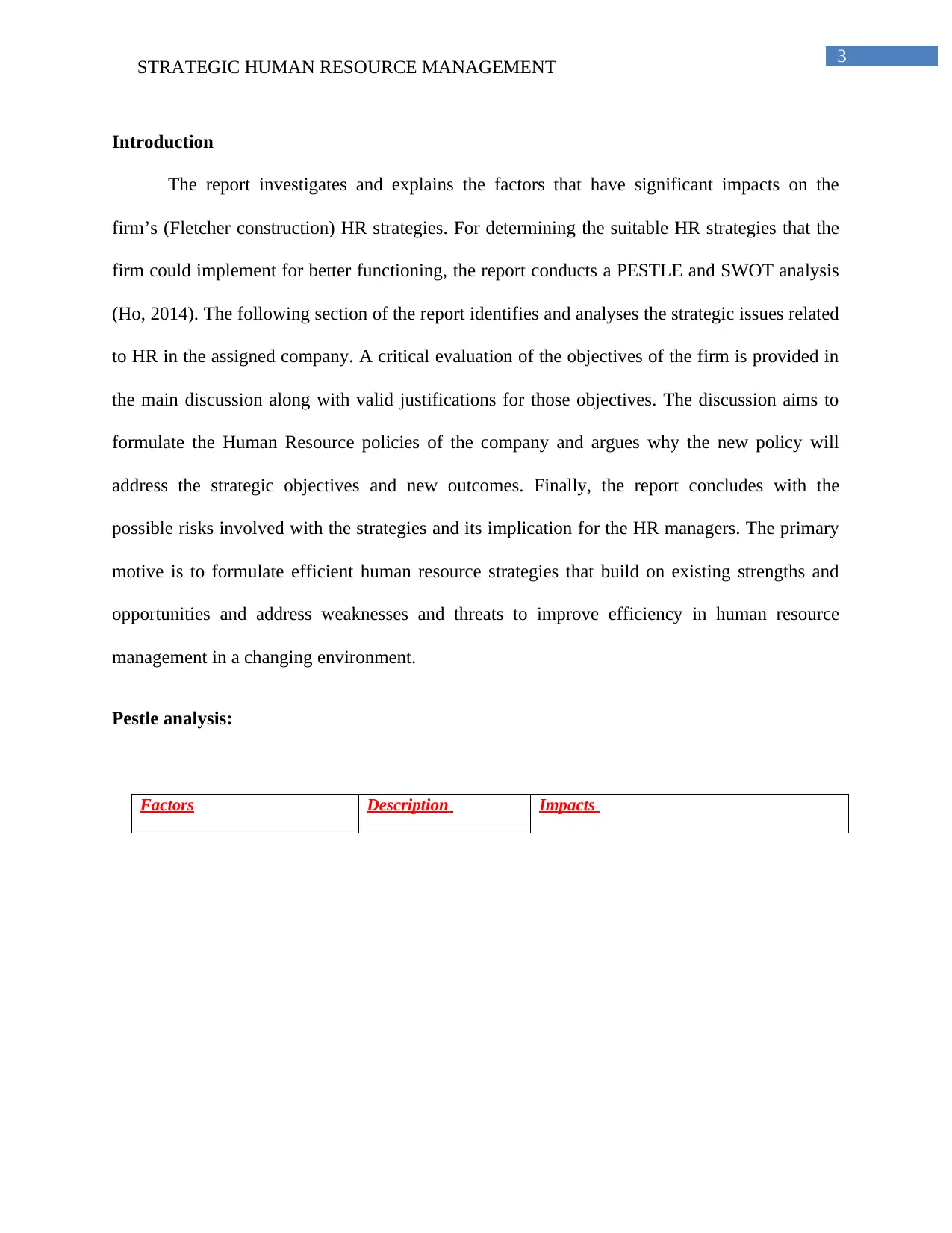
3
STRATEGIC HUMAN RESOURCE MANAGEMENT
Introduction
The report investigates and explains the factors that have significant impacts on the
firm’s (Fletcher construction) HR strategies. For determining the suitable HR strategies that the
firm could implement for better functioning, the report conducts a PESTLE and SWOT analysis
(Ho, 2014). The following section of the report identifies and analyses the strategic issues related
to HR in the assigned company. A critical evaluation of the objectives of the firm is provided in
the main discussion along with valid justifications for those objectives. The discussion aims to
formulate the Human Resource policies of the company and argues why the new policy will
address the strategic objectives and new outcomes. Finally, the report concludes with the
possible risks involved with the strategies and its implication for the HR managers. The primary
motive is to formulate efficient human resource strategies that build on existing strengths and
opportunities and address weaknesses and threats to improve efficiency in human resource
management in a changing environment.
Pestle analysis:
Factors Description Impacts
STRATEGIC HUMAN RESOURCE MANAGEMENT
Introduction
The report investigates and explains the factors that have significant impacts on the
firm’s (Fletcher construction) HR strategies. For determining the suitable HR strategies that the
firm could implement for better functioning, the report conducts a PESTLE and SWOT analysis
(Ho, 2014). The following section of the report identifies and analyses the strategic issues related
to HR in the assigned company. A critical evaluation of the objectives of the firm is provided in
the main discussion along with valid justifications for those objectives. The discussion aims to
formulate the Human Resource policies of the company and argues why the new policy will
address the strategic objectives and new outcomes. Finally, the report concludes with the
possible risks involved with the strategies and its implication for the HR managers. The primary
motive is to formulate efficient human resource strategies that build on existing strengths and
opportunities and address weaknesses and threats to improve efficiency in human resource
management in a changing environment.
Pestle analysis:
Factors Description Impacts
Paraphrase This Document
Need a fresh take? Get an instant paraphrase of this document with our AI Paraphraser
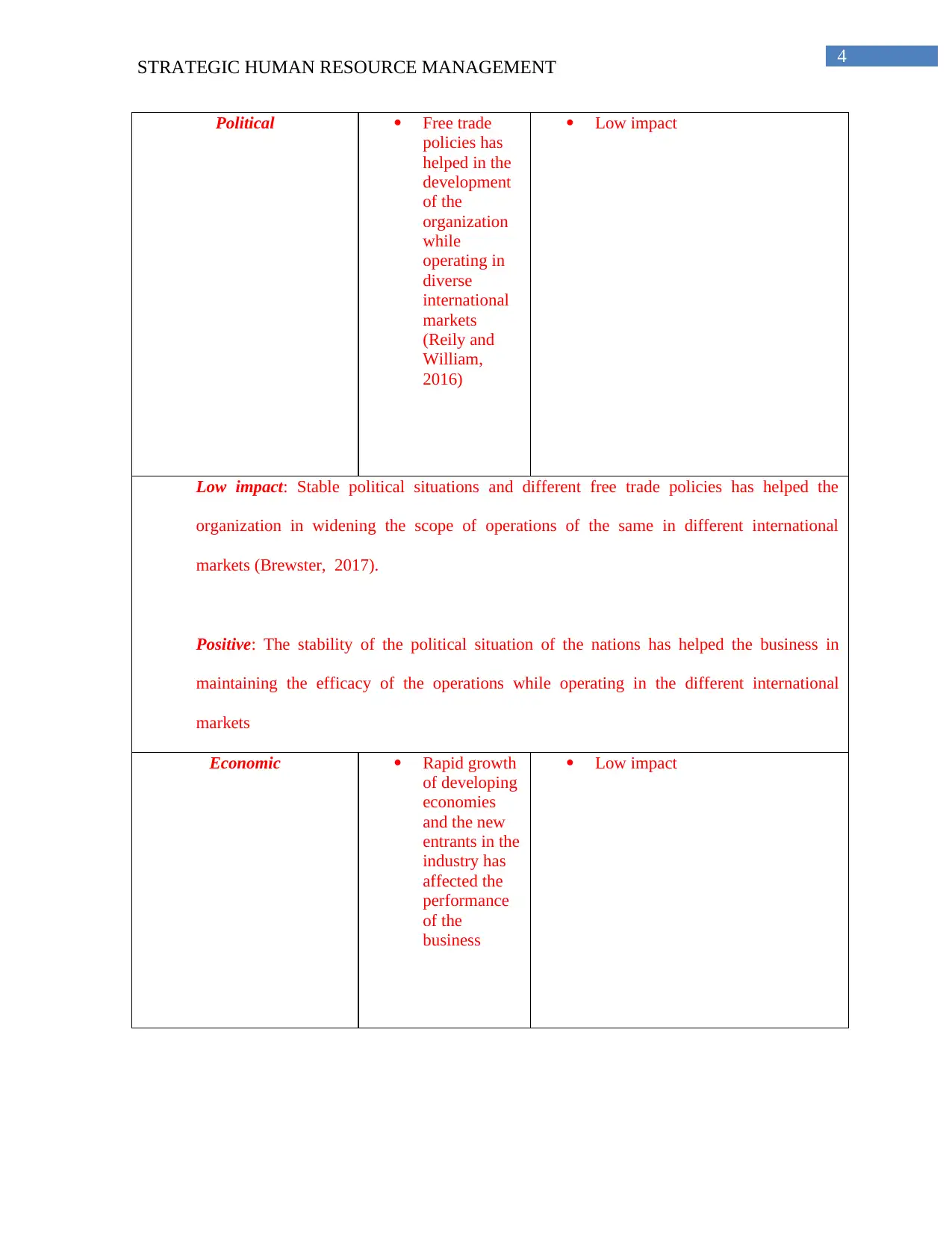
4
STRATEGIC HUMAN RESOURCE MANAGEMENT
Political Free trade
policies has
helped in the
development
of the
organization
while
operating in
diverse
international
markets
(Reily and
William,
2016)
Low impact
Low impact: Stable political situations and different free trade policies has helped the
organization in widening the scope of operations of the same in different international
markets (Brewster, 2017).
Positive: The stability of the political situation of the nations has helped the business in
maintaining the efficacy of the operations while operating in the different international
markets
Economic Rapid growth
of developing
economies
and the new
entrants in the
industry has
affected the
performance
of the
business
Low impact
STRATEGIC HUMAN RESOURCE MANAGEMENT
Political Free trade
policies has
helped in the
development
of the
organization
while
operating in
diverse
international
markets
(Reily and
William,
2016)
Low impact
Low impact: Stable political situations and different free trade policies has helped the
organization in widening the scope of operations of the same in different international
markets (Brewster, 2017).
Positive: The stability of the political situation of the nations has helped the business in
maintaining the efficacy of the operations while operating in the different international
markets
Economic Rapid growth
of developing
economies
and the new
entrants in the
industry has
affected the
performance
of the
business
Low impact
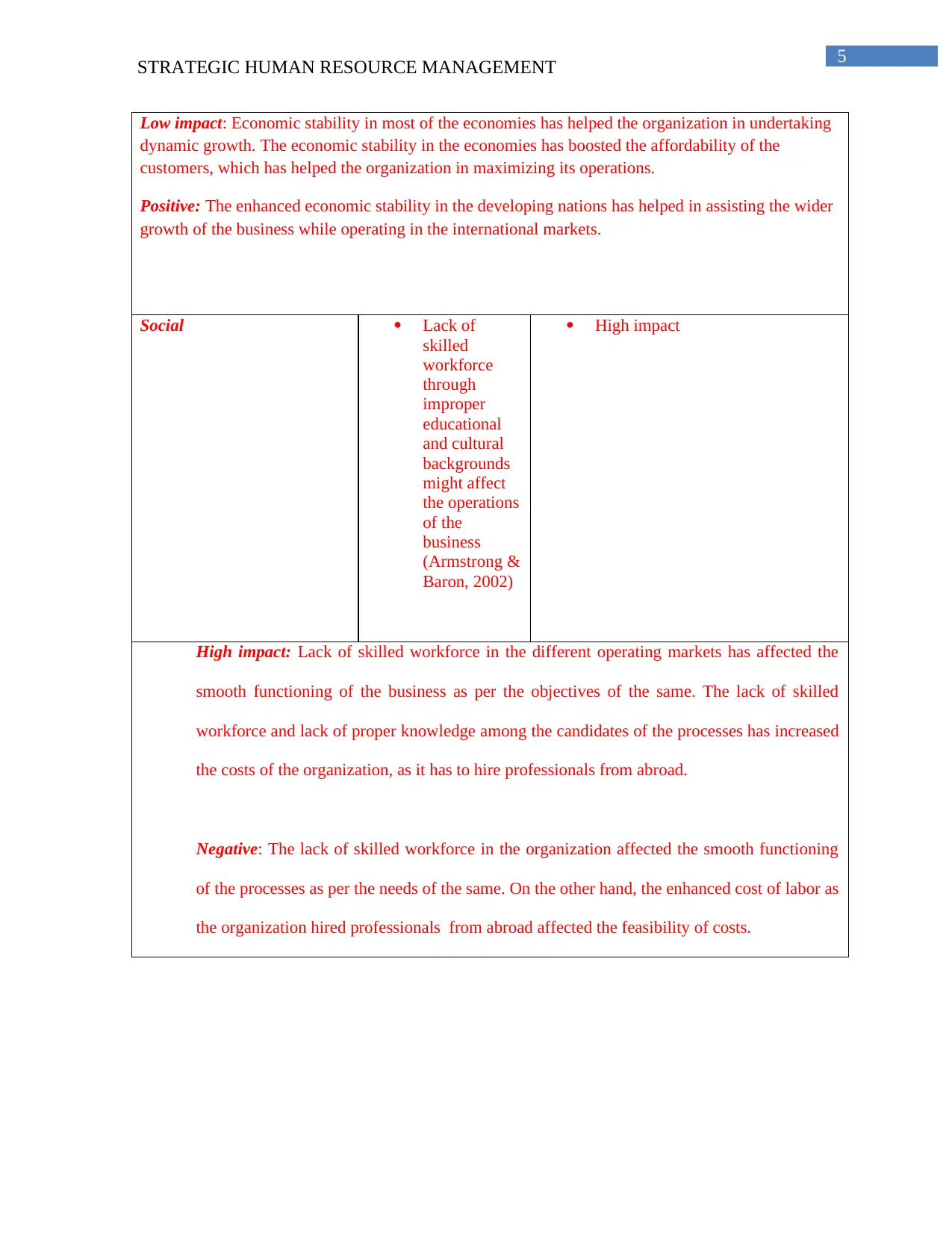
5
STRATEGIC HUMAN RESOURCE MANAGEMENT
Low impact: Economic stability in most of the economies has helped the organization in undertaking
dynamic growth. The economic stability in the economies has boosted the affordability of the
customers, which has helped the organization in maximizing its operations.
Positive: The enhanced economic stability in the developing nations has helped in assisting the wider
growth of the business while operating in the international markets.
Social Lack of
skilled
workforce
through
improper
educational
and cultural
backgrounds
might affect
the operations
of the
business
(Armstrong &
Baron, 2002)
High impact
High impact: Lack of skilled workforce in the different operating markets has affected the
smooth functioning of the business as per the objectives of the same. The lack of skilled
workforce and lack of proper knowledge among the candidates of the processes has increased
the costs of the organization, as it has to hire professionals from abroad.
Negative: The lack of skilled workforce in the organization affected the smooth functioning
of the processes as per the needs of the same. On the other hand, the enhanced cost of labor as
the organization hired professionals from abroad affected the feasibility of costs.
STRATEGIC HUMAN RESOURCE MANAGEMENT
Low impact: Economic stability in most of the economies has helped the organization in undertaking
dynamic growth. The economic stability in the economies has boosted the affordability of the
customers, which has helped the organization in maximizing its operations.
Positive: The enhanced economic stability in the developing nations has helped in assisting the wider
growth of the business while operating in the international markets.
Social Lack of
skilled
workforce
through
improper
educational
and cultural
backgrounds
might affect
the operations
of the
business
(Armstrong &
Baron, 2002)
High impact
High impact: Lack of skilled workforce in the different operating markets has affected the
smooth functioning of the business as per the objectives of the same. The lack of skilled
workforce and lack of proper knowledge among the candidates of the processes has increased
the costs of the organization, as it has to hire professionals from abroad.
Negative: The lack of skilled workforce in the organization affected the smooth functioning
of the processes as per the needs of the same. On the other hand, the enhanced cost of labor as
the organization hired professionals from abroad affected the feasibility of costs.
⊘ This is a preview!⊘
Do you want full access?
Subscribe today to unlock all pages.

Trusted by 1+ million students worldwide
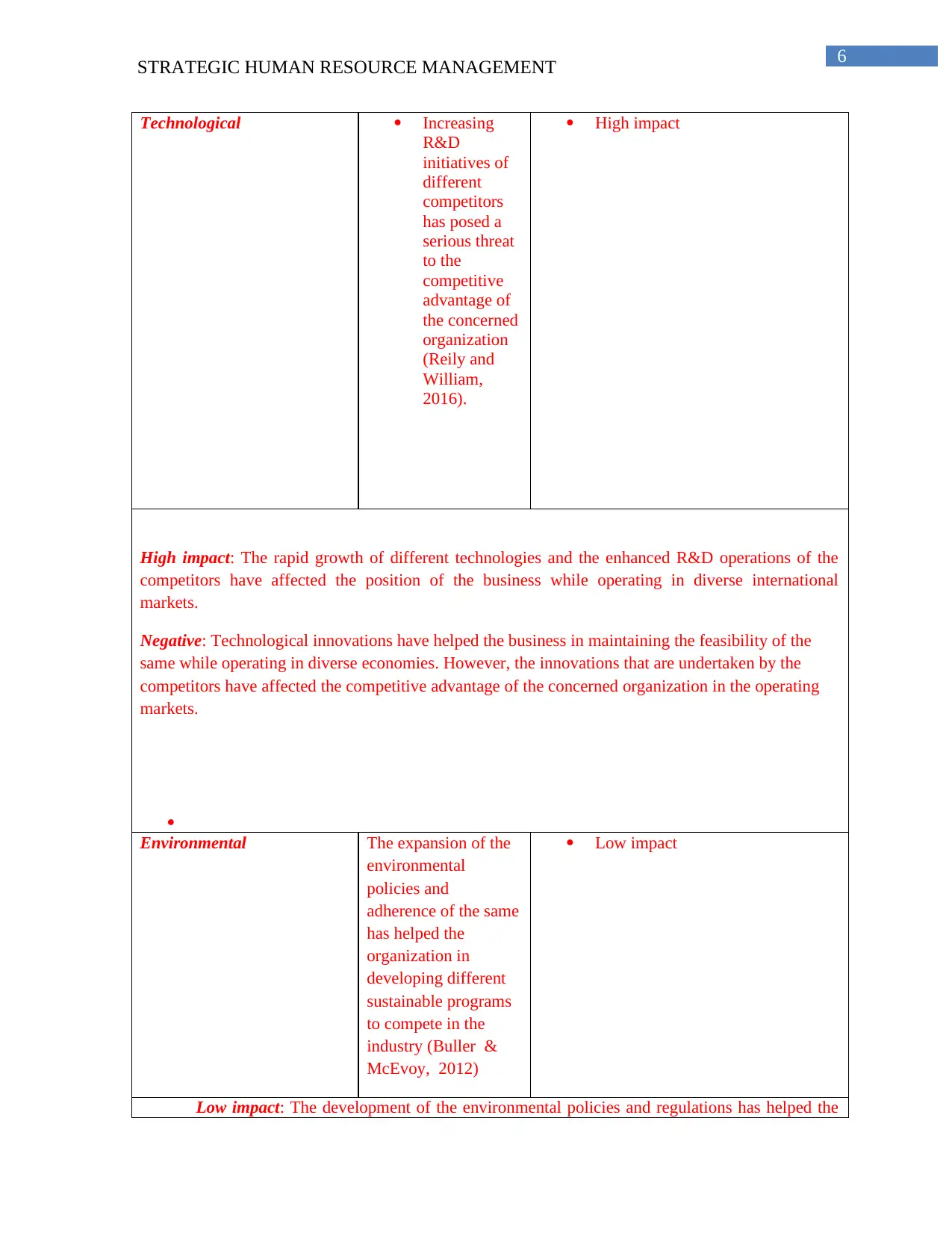
6
STRATEGIC HUMAN RESOURCE MANAGEMENT
Technological Increasing
R&D
initiatives of
different
competitors
has posed a
serious threat
to the
competitive
advantage of
the concerned
organization
(Reily and
William,
2016).
High impact
High impact: The rapid growth of different technologies and the enhanced R&D operations of the
competitors have affected the position of the business while operating in diverse international
markets.
Negative: Technological innovations have helped the business in maintaining the feasibility of the
same while operating in diverse economies. However, the innovations that are undertaken by the
competitors have affected the competitive advantage of the concerned organization in the operating
markets.
Environmental The expansion of the
environmental
policies and
adherence of the same
has helped the
organization in
developing different
sustainable programs
to compete in the
industry (Buller &
McEvoy, 2012)
Low impact
Low impact: The development of the environmental policies and regulations has helped the
STRATEGIC HUMAN RESOURCE MANAGEMENT
Technological Increasing
R&D
initiatives of
different
competitors
has posed a
serious threat
to the
competitive
advantage of
the concerned
organization
(Reily and
William,
2016).
High impact
High impact: The rapid growth of different technologies and the enhanced R&D operations of the
competitors have affected the position of the business while operating in diverse international
markets.
Negative: Technological innovations have helped the business in maintaining the feasibility of the
same while operating in diverse economies. However, the innovations that are undertaken by the
competitors have affected the competitive advantage of the concerned organization in the operating
markets.
Environmental The expansion of the
environmental
policies and
adherence of the same
has helped the
organization in
developing different
sustainable programs
to compete in the
industry (Buller &
McEvoy, 2012)
Low impact
Low impact: The development of the environmental policies and regulations has helped the
Paraphrase This Document
Need a fresh take? Get an instant paraphrase of this document with our AI Paraphraser
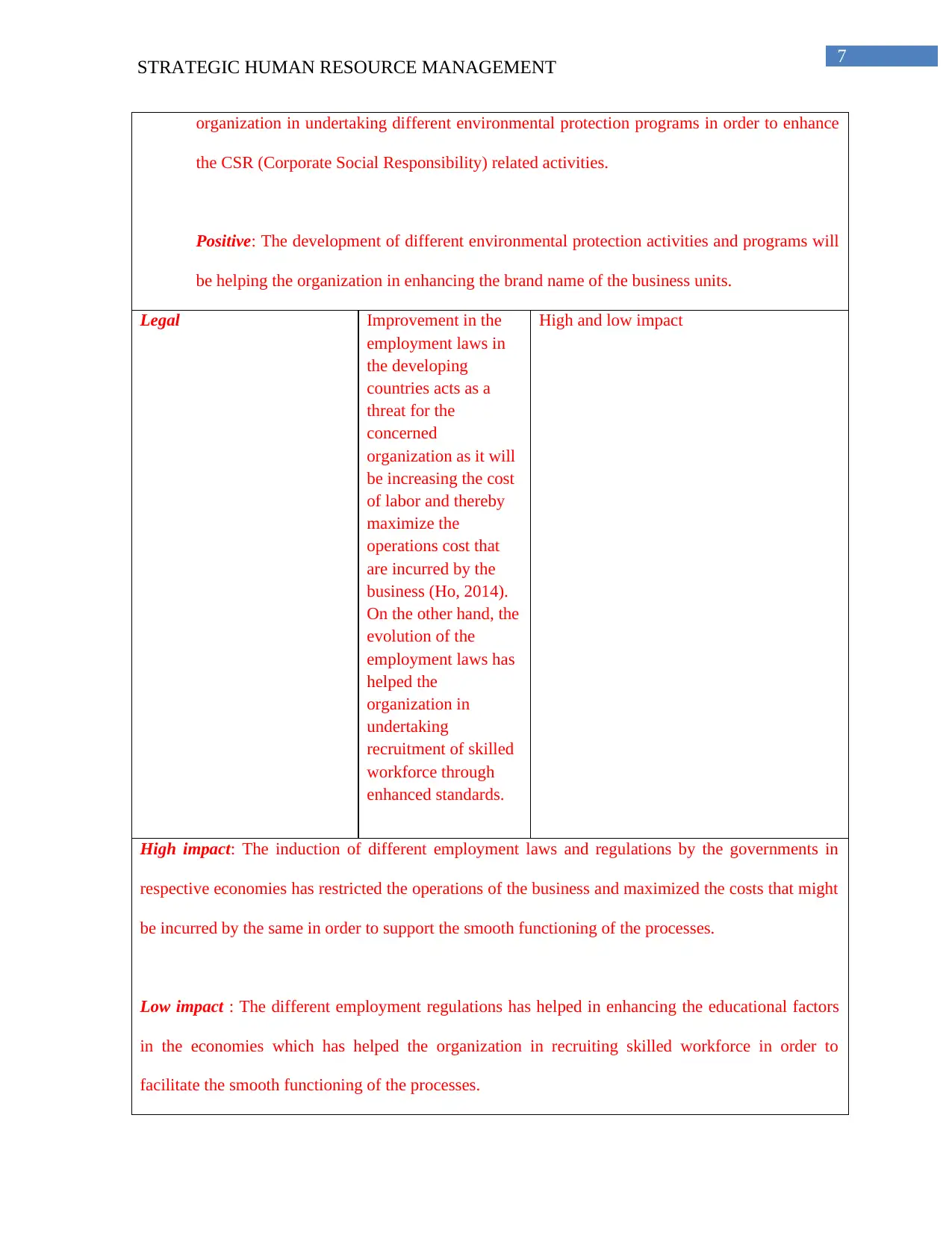
7
STRATEGIC HUMAN RESOURCE MANAGEMENT
organization in undertaking different environmental protection programs in order to enhance
the CSR (Corporate Social Responsibility) related activities.
Positive: The development of different environmental protection activities and programs will
be helping the organization in enhancing the brand name of the business units.
Legal Improvement in the
employment laws in
the developing
countries acts as a
threat for the
concerned
organization as it will
be increasing the cost
of labor and thereby
maximize the
operations cost that
are incurred by the
business (Ho, 2014).
On the other hand, the
evolution of the
employment laws has
helped the
organization in
undertaking
recruitment of skilled
workforce through
enhanced standards.
High and low impact
High impact: The induction of different employment laws and regulations by the governments in
respective economies has restricted the operations of the business and maximized the costs that might
be incurred by the same in order to support the smooth functioning of the processes.
Low impact : The different employment regulations has helped in enhancing the educational factors
in the economies which has helped the organization in recruiting skilled workforce in order to
facilitate the smooth functioning of the processes.
STRATEGIC HUMAN RESOURCE MANAGEMENT
organization in undertaking different environmental protection programs in order to enhance
the CSR (Corporate Social Responsibility) related activities.
Positive: The development of different environmental protection activities and programs will
be helping the organization in enhancing the brand name of the business units.
Legal Improvement in the
employment laws in
the developing
countries acts as a
threat for the
concerned
organization as it will
be increasing the cost
of labor and thereby
maximize the
operations cost that
are incurred by the
business (Ho, 2014).
On the other hand, the
evolution of the
employment laws has
helped the
organization in
undertaking
recruitment of skilled
workforce through
enhanced standards.
High and low impact
High impact: The induction of different employment laws and regulations by the governments in
respective economies has restricted the operations of the business and maximized the costs that might
be incurred by the same in order to support the smooth functioning of the processes.
Low impact : The different employment regulations has helped in enhancing the educational factors
in the economies which has helped the organization in recruiting skilled workforce in order to
facilitate the smooth functioning of the processes.
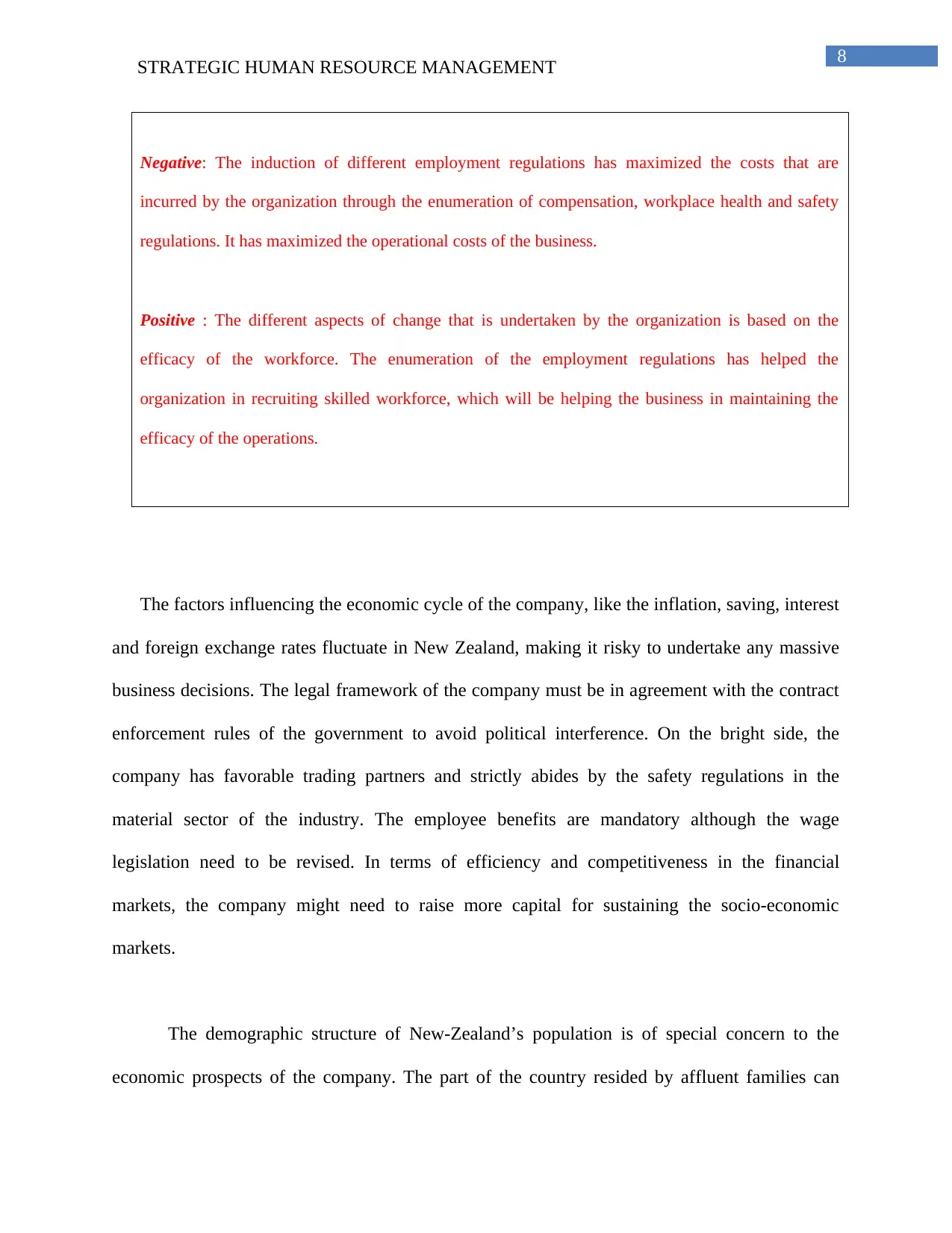
8
STRATEGIC HUMAN RESOURCE MANAGEMENT
Negative: The induction of different employment regulations has maximized the costs that are
incurred by the organization through the enumeration of compensation, workplace health and safety
regulations. It has maximized the operational costs of the business.
Positive : The different aspects of change that is undertaken by the organization is based on the
efficacy of the workforce. The enumeration of the employment regulations has helped the
organization in recruiting skilled workforce, which will be helping the business in maintaining the
efficacy of the operations.
The factors influencing the economic cycle of the company, like the inflation, saving, interest
and foreign exchange rates fluctuate in New Zealand, making it risky to undertake any massive
business decisions. The legal framework of the company must be in agreement with the contract
enforcement rules of the government to avoid political interference. On the bright side, the
company has favorable trading partners and strictly abides by the safety regulations in the
material sector of the industry. The employee benefits are mandatory although the wage
legislation need to be revised. In terms of efficiency and competitiveness in the financial
markets, the company might need to raise more capital for sustaining the socio-economic
markets.
The demographic structure of New-Zealand’s population is of special concern to the
economic prospects of the company. The part of the country resided by affluent families can
STRATEGIC HUMAN RESOURCE MANAGEMENT
Negative: The induction of different employment regulations has maximized the costs that are
incurred by the organization through the enumeration of compensation, workplace health and safety
regulations. It has maximized the operational costs of the business.
Positive : The different aspects of change that is undertaken by the organization is based on the
efficacy of the workforce. The enumeration of the employment regulations has helped the
organization in recruiting skilled workforce, which will be helping the business in maintaining the
efficacy of the operations.
The factors influencing the economic cycle of the company, like the inflation, saving, interest
and foreign exchange rates fluctuate in New Zealand, making it risky to undertake any massive
business decisions. The legal framework of the company must be in agreement with the contract
enforcement rules of the government to avoid political interference. On the bright side, the
company has favorable trading partners and strictly abides by the safety regulations in the
material sector of the industry. The employee benefits are mandatory although the wage
legislation need to be revised. In terms of efficiency and competitiveness in the financial
markets, the company might need to raise more capital for sustaining the socio-economic
markets.
The demographic structure of New-Zealand’s population is of special concern to the
economic prospects of the company. The part of the country resided by affluent families can
⊘ This is a preview!⊘
Do you want full access?
Subscribe today to unlock all pages.

Trusted by 1+ million students worldwide
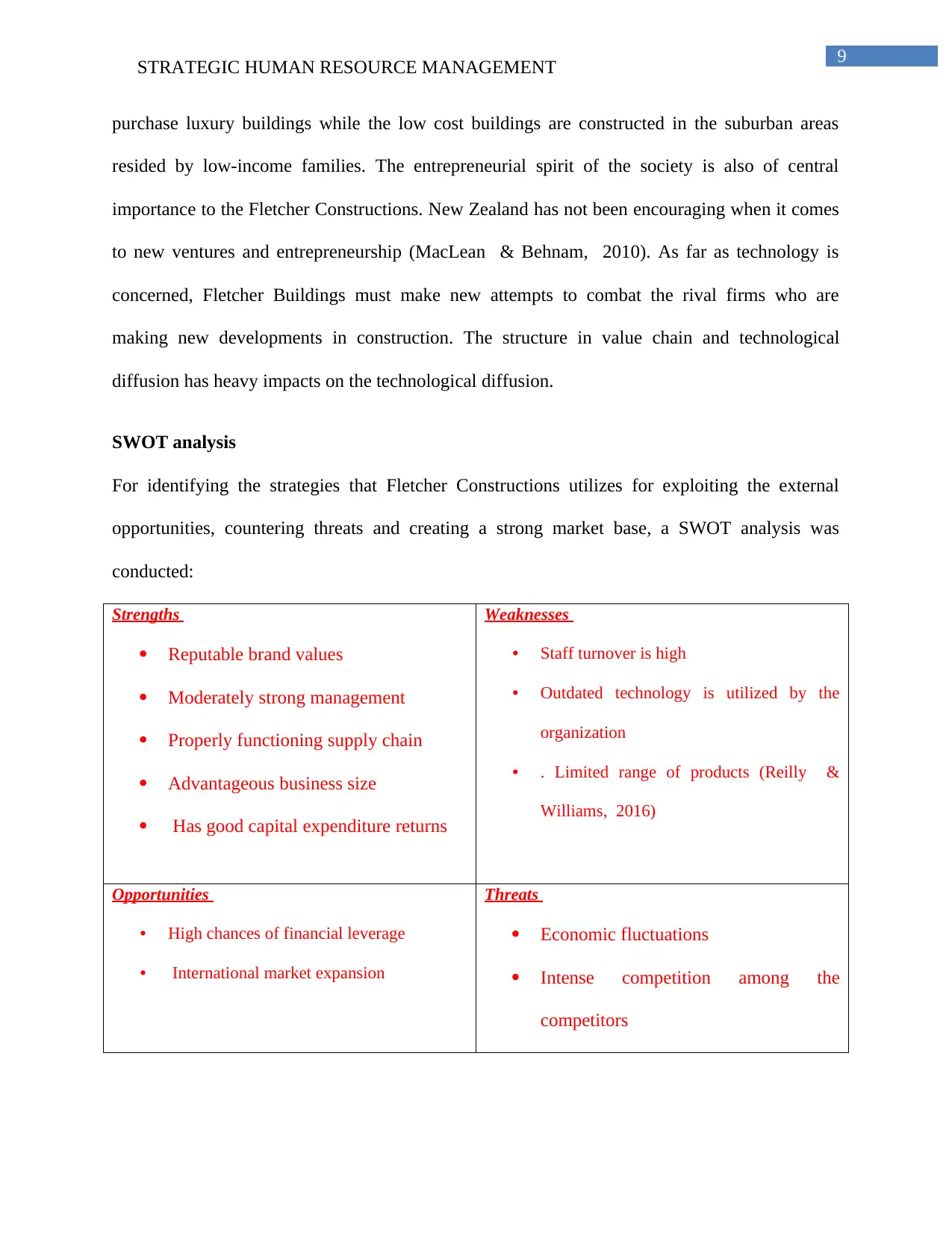
9
STRATEGIC HUMAN RESOURCE MANAGEMENT
purchase luxury buildings while the low cost buildings are constructed in the suburban areas
resided by low-income families. The entrepreneurial spirit of the society is also of central
importance to the Fletcher Constructions. New Zealand has not been encouraging when it comes
to new ventures and entrepreneurship (MacLean & Behnam, 2010). As far as technology is
concerned, Fletcher Buildings must make new attempts to combat the rival firms who are
making new developments in construction. The structure in value chain and technological
diffusion has heavy impacts on the technological diffusion.
SWOT analysis
For identifying the strategies that Fletcher Constructions utilizes for exploiting the external
opportunities, countering threats and creating a strong market base, a SWOT analysis was
conducted:
Strengths
Reputable brand values
Moderately strong management
Properly functioning supply chain
Advantageous business size
Has good capital expenditure returns
Weaknesses
• Staff turnover is high
• Outdated technology is utilized by the
organization
• . Limited range of products (Reilly &
Williams, 2016)
Opportunities
• High chances of financial leverage
• International market expansion
Threats
Economic fluctuations
Intense competition among the
competitors
STRATEGIC HUMAN RESOURCE MANAGEMENT
purchase luxury buildings while the low cost buildings are constructed in the suburban areas
resided by low-income families. The entrepreneurial spirit of the society is also of central
importance to the Fletcher Constructions. New Zealand has not been encouraging when it comes
to new ventures and entrepreneurship (MacLean & Behnam, 2010). As far as technology is
concerned, Fletcher Buildings must make new attempts to combat the rival firms who are
making new developments in construction. The structure in value chain and technological
diffusion has heavy impacts on the technological diffusion.
SWOT analysis
For identifying the strategies that Fletcher Constructions utilizes for exploiting the external
opportunities, countering threats and creating a strong market base, a SWOT analysis was
conducted:
Strengths
Reputable brand values
Moderately strong management
Properly functioning supply chain
Advantageous business size
Has good capital expenditure returns
Weaknesses
• Staff turnover is high
• Outdated technology is utilized by the
organization
• . Limited range of products (Reilly &
Williams, 2016)
Opportunities
• High chances of financial leverage
• International market expansion
Threats
Economic fluctuations
Intense competition among the
competitors
Paraphrase This Document
Need a fresh take? Get an instant paraphrase of this document with our AI Paraphraser
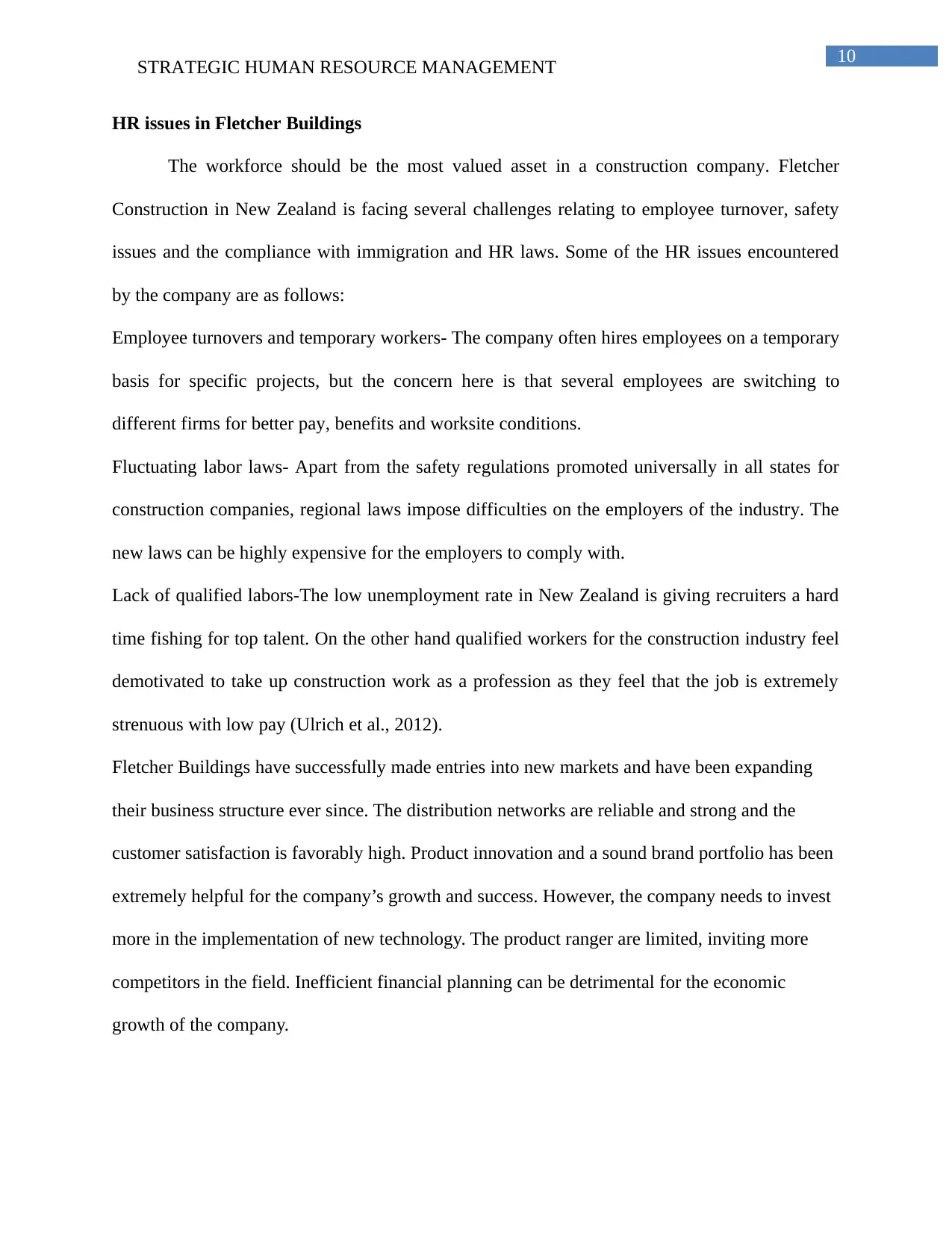
10
STRATEGIC HUMAN RESOURCE MANAGEMENT
HR issues in Fletcher Buildings
The workforce should be the most valued asset in a construction company. Fletcher
Construction in New Zealand is facing several challenges relating to employee turnover, safety
issues and the compliance with immigration and HR laws. Some of the HR issues encountered
by the company are as follows:
Employee turnovers and temporary workers- The company often hires employees on a temporary
basis for specific projects, but the concern here is that several employees are switching to
different firms for better pay, benefits and worksite conditions.
Fluctuating labor laws- Apart from the safety regulations promoted universally in all states for
construction companies, regional laws impose difficulties on the employers of the industry. The
new laws can be highly expensive for the employers to comply with.
Lack of qualified labors-The low unemployment rate in New Zealand is giving recruiters a hard
time fishing for top talent. On the other hand qualified workers for the construction industry feel
demotivated to take up construction work as a profession as they feel that the job is extremely
strenuous with low pay (Ulrich et al., 2012).
Fletcher Buildings have successfully made entries into new markets and have been expanding
their business structure ever since. The distribution networks are reliable and strong and the
customer satisfaction is favorably high. Product innovation and a sound brand portfolio has been
extremely helpful for the company’s growth and success. However, the company needs to invest
more in the implementation of new technology. The product ranger are limited, inviting more
competitors in the field. Inefficient financial planning can be detrimental for the economic
growth of the company.
STRATEGIC HUMAN RESOURCE MANAGEMENT
HR issues in Fletcher Buildings
The workforce should be the most valued asset in a construction company. Fletcher
Construction in New Zealand is facing several challenges relating to employee turnover, safety
issues and the compliance with immigration and HR laws. Some of the HR issues encountered
by the company are as follows:
Employee turnovers and temporary workers- The company often hires employees on a temporary
basis for specific projects, but the concern here is that several employees are switching to
different firms for better pay, benefits and worksite conditions.
Fluctuating labor laws- Apart from the safety regulations promoted universally in all states for
construction companies, regional laws impose difficulties on the employers of the industry. The
new laws can be highly expensive for the employers to comply with.
Lack of qualified labors-The low unemployment rate in New Zealand is giving recruiters a hard
time fishing for top talent. On the other hand qualified workers for the construction industry feel
demotivated to take up construction work as a profession as they feel that the job is extremely
strenuous with low pay (Ulrich et al., 2012).
Fletcher Buildings have successfully made entries into new markets and have been expanding
their business structure ever since. The distribution networks are reliable and strong and the
customer satisfaction is favorably high. Product innovation and a sound brand portfolio has been
extremely helpful for the company’s growth and success. However, the company needs to invest
more in the implementation of new technology. The product ranger are limited, inviting more
competitors in the field. Inefficient financial planning can be detrimental for the economic
growth of the company.
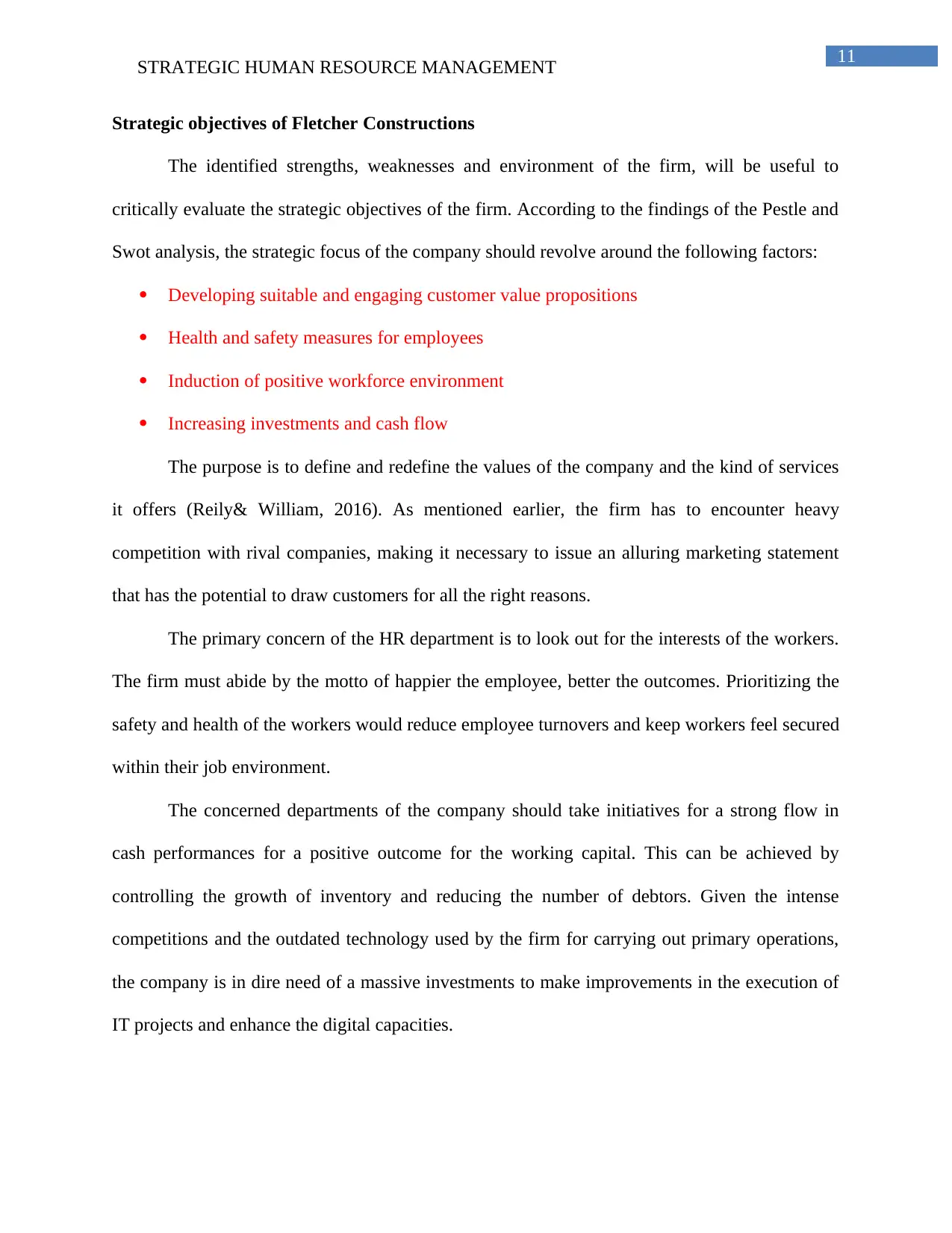
11
STRATEGIC HUMAN RESOURCE MANAGEMENT
Strategic objectives of Fletcher Constructions
The identified strengths, weaknesses and environment of the firm, will be useful to
critically evaluate the strategic objectives of the firm. According to the findings of the Pestle and
Swot analysis, the strategic focus of the company should revolve around the following factors:
Developing suitable and engaging customer value propositions
Health and safety measures for employees
Induction of positive workforce environment
Increasing investments and cash flow
The purpose is to define and redefine the values of the company and the kind of services
it offers (Reily& William, 2016). As mentioned earlier, the firm has to encounter heavy
competition with rival companies, making it necessary to issue an alluring marketing statement
that has the potential to draw customers for all the right reasons.
The primary concern of the HR department is to look out for the interests of the workers.
The firm must abide by the motto of happier the employee, better the outcomes. Prioritizing the
safety and health of the workers would reduce employee turnovers and keep workers feel secured
within their job environment.
The concerned departments of the company should take initiatives for a strong flow in
cash performances for a positive outcome for the working capital. This can be achieved by
controlling the growth of inventory and reducing the number of debtors. Given the intense
competitions and the outdated technology used by the firm for carrying out primary operations,
the company is in dire need of a massive investments to make improvements in the execution of
IT projects and enhance the digital capacities.
STRATEGIC HUMAN RESOURCE MANAGEMENT
Strategic objectives of Fletcher Constructions
The identified strengths, weaknesses and environment of the firm, will be useful to
critically evaluate the strategic objectives of the firm. According to the findings of the Pestle and
Swot analysis, the strategic focus of the company should revolve around the following factors:
Developing suitable and engaging customer value propositions
Health and safety measures for employees
Induction of positive workforce environment
Increasing investments and cash flow
The purpose is to define and redefine the values of the company and the kind of services
it offers (Reily& William, 2016). As mentioned earlier, the firm has to encounter heavy
competition with rival companies, making it necessary to issue an alluring marketing statement
that has the potential to draw customers for all the right reasons.
The primary concern of the HR department is to look out for the interests of the workers.
The firm must abide by the motto of happier the employee, better the outcomes. Prioritizing the
safety and health of the workers would reduce employee turnovers and keep workers feel secured
within their job environment.
The concerned departments of the company should take initiatives for a strong flow in
cash performances for a positive outcome for the working capital. This can be achieved by
controlling the growth of inventory and reducing the number of debtors. Given the intense
competitions and the outdated technology used by the firm for carrying out primary operations,
the company is in dire need of a massive investments to make improvements in the execution of
IT projects and enhance the digital capacities.
⊘ This is a preview!⊘
Do you want full access?
Subscribe today to unlock all pages.

Trusted by 1+ million students worldwide
1 out of 20
Related Documents
Your All-in-One AI-Powered Toolkit for Academic Success.
+13062052269
info@desklib.com
Available 24*7 on WhatsApp / Email
![[object Object]](/_next/static/media/star-bottom.7253800d.svg)
Unlock your academic potential
Copyright © 2020–2025 A2Z Services. All Rights Reserved. Developed and managed by ZUCOL.





